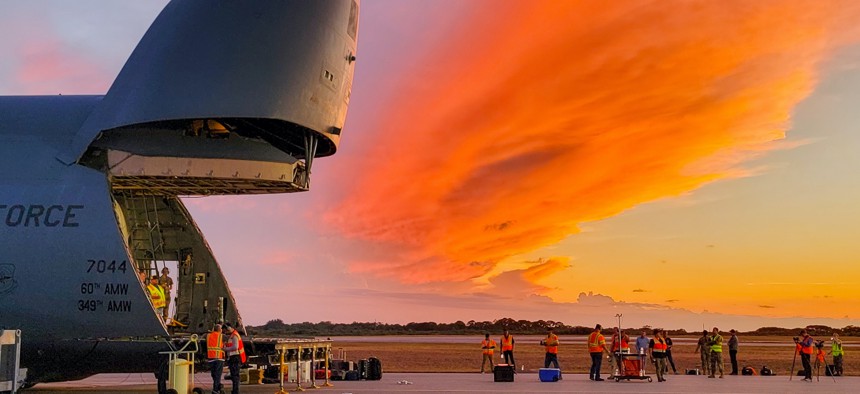
Loadmasters from the 60th Air Mobility Wing and Lockheed Martin Space unload the sixth Geosynchronous Earth Orbit Space Based Infrared System satellite (SBIRS GEO-6) from a C-5M Super Galaxy at Cape Canaveral Space Force Station, Fla., June 2, 2022. U.S. Space Force / Walter Talens
Tomorrow’s Missile-Warning Satellites Will Join SBIRS, Not Replace Them: Space Systems Command
Off-the-shelf spacecraft and lunar-mission gear are also on the table for Space Force’s acquisition command.
A set of five planned U.S. missile-warning satellites are often described as “replacing” the Space-Based Infrared Systems satellites that currently keep an eye out for enemy launches. That’s not the case, a Space Systems Command leader said Wednesday.
Instead, the Pentagon’s Next Generation Overhead Persistent Infrared, or OPIR, satellites will be integrated with the existing SBIRS constellation, said Col. “Rhet” Turnbull, deputy director of the Space Systems Integration Office. His office is part of U.S. Space Systems Command, the 10-month-old center that leads Space Force acquisitions and technology development.
“We rarely throw anything away that's working well,” Turnbull said. “They will still continue to be part of the architecture.”
By keeping both, he said, “We can continue to utilize not just the things that we already have…exploit what we have, but we can bring in new data much more quickly.”
Starting in 2025, the OPIR satellites are to join the decade-old SBIRS constellation in geosynchronous orbit some 22,200 miles up, allowing each one to maintain station above a different point on the Earth’s surface. The combined constellations will encircle the Earth, with some satellites remaining stationary over the North and South poles, to provide a more resilient detection capability, Turnbull said.
Meanwhile, SSC is also developing a ground system called FORGE that will fuse data from old and new satellites alike, he said.
“That will be a really powerful capability to provide our operators, because they won't have to look at a lot of different screens, one for each satellite,” Turnbull said.
As the Space Force’s acquisition lead, SSC is also focused on the nearer-Earth threats posed by low Earth orbit satellites and debris, as potential adversaries test the ability to blind satellites, or grab them with a mechanical arm, as China did with the Shijian (SJ)-17 satellite, or simply shoot them down, as Russia did just two months before invading Ukraine.
With China, “they demonstrated recently grabbing a satellite and taking it out of orbit and putting it into a different orbit,” Turnbull said. While that was a peaceful test, “you can imagine how you could use that capability in a less benign way.”
All this has SSC looking at how quickly it could replace a downed satellite. The command is starting with the LEO threats first. In March, it issued a solicitation for firms under the Tactically Responsive Space Program seeking ideas.
“Tactical response of space is about being able to do that entire timeline much more compressed,” in months or weeks. “I can't talk right now about specific capabilities that we would use,” he said, “but I can tell you that it is, it is going to really radically shift.”
All ideas are on the table, from having satellites already built to forming an agreement with industry to be able to get one from an ongoing assembly line, Turnbull said.
Last, with Moon missions on the horizon, the command is starting to think about what sort of needs a future lunar presence would require.
“That's definitely an area we have thought a lot about,” Turnbull said, although there are not a lot of Moon-focused programs at the Command yet.
“If you're going to operate on the Moon you're going to need many of the same services that you need on Earth. You will need navigation and timing; those are services our GPS systems provide here on Earth today.”
That could mean that the U.S. and others begin to encircle the moon with satellites, just as they have encircled the Earth. It will likely mean satellites in non-traditional elliptical orbits between the Earth and Moon as well, Turnbull said.
“Certainly some of the focus in the future is, ‘How do we provide that space domain awareness around the Moon?’” Turnbull said. “To do that, you're going to need sensors and satellites.”





